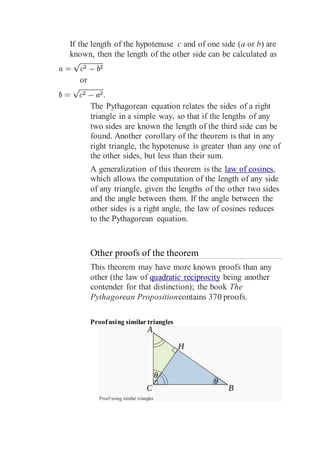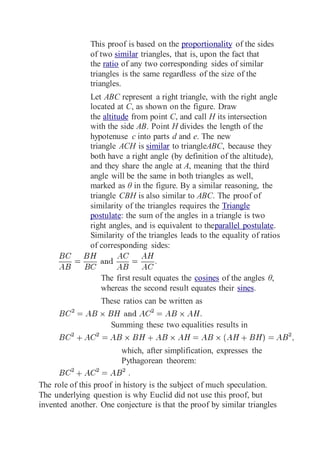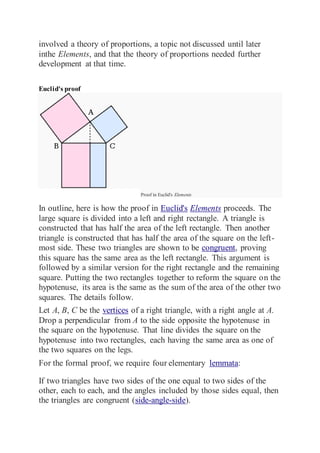The Pythagorean theorem states that in a right triangle, the square of the hypotenuse is equal to the sum of the squares of the other two sides. It is named after Pythagoras, who is often credited with its proof, although it was known by earlier mathematicians as well. There are many different proofs of the theorem, including Pythagoras' original proof by rearrangement of triangles and Euclid's algebraic proof in his Elements which constructs squares on each side and uses their areas to prove the relationship.
![Pythagorean theorem
The Pythagorean Theorem: The sum of the areas of the two squares on the legs
(a and b) equals the area of the square on the hypotenuse (c).
In mathematics, the Pythagorean theorem—or Pythagoras' theorem—is a
relation in Euclidean geometry among the three sides of aright triangle. It states
that the square of the hypotenuse (the side opposite the right angle) is equal to
the sum of the squares of the other two sides. The theorem can be written as
an equation relating the lengths of the sides a, b and c, often called
the Pythagorean equation:[1]
where c represents the length of the hypotenuse, and a and b represent the
lengths of the other two sides.
The Pythagorean theorem is named after
the Greek mathematician Pythagoras (ca. 570 BC—ca. 495 BC), who by
tradition is credited with its proof,[2][3] although it is often argued that
knowledge of the theorem predates him. There is evidence that Babylonian
mathematiciansunderstood the formula, although there is little surviving
evidence that they used it in a mathematical
framework] Mesopotamian, Indianand Chinese mathematicians have all been
known for independently discovering the result, some even providing proofs
of special cases.
The theorem has numerous proofs, possibly the most of any mathematical
theorem. These are very diverse, including both geometric proofs and
algebraic proofs, with some dating back thousands of years. The theorem
can be generalized in various ways, including higher-dimensional spaces, to
spaces that are not Euclidean, to objects that are not right triangles, and
indeed, to objects that are not triangles at all, but n-dimensional solids. The
Pythagorean theorem has attracted interest outside mathematics as a symbol
of mathematical abstruseness, mystique, or intellectual power; popular
references in literature, plays, musicals, songs, stamps and cartoons abound.](https://image.slidesharecdn.com/pythagoreantheorem-140918025806-phpapp01/85/Pythagorean-theorem-1-320.jpg)
![Pythagorean proof
The Pythagorean proof
The Pythagorean Theorem was known long before Pythagoras, but
he may well have been the first to prove it.[6] In any event, the
proof attributed to him is very simple, and is called a proof by
rearrangement.
The two large squares shown in the figure each contain four
identical triangles, and the only difference between the two large
squares is that the triangles are arranged differently. Therefore, the
white space within each of the two large squares must have equal
area. Equating the area of the white space yields the Pythagorean
Theorem, Q.E.D.[7]
That Pythagoras originated this very simple proof is sometimes
inferred from the writings of the later Greek philosopher and
mathematicianProclus.[8] Several other proofs of this theorem are
described below, but this is known as the Pythagorean one.
Other forms of the theorem
As pointed out in the introduction, if c denotes the length of the
hypotenuse and a and b denote the lengths of the other two sides,
the Pythagorean theorem can be expressed as the Pythagorean
equation:
If the length of both a and b are known, then c can be calculated
as](https://image.slidesharecdn.com/pythagoreantheorem-140918025806-phpapp01/85/Pythagorean-theorem-2-320.jpg)



![The area of a triangle is half the area of any parallelogram on the
same base and having the same altitude.
The area of a rectangle is equal to the product of two adjacent sides.
The area of a square is equal to the product of two of its sides (follows
from 3).
Next, each top square is related to a triangle congruent with another
triangle related in turn to one of two rectangles making up the lower
square.[12]
Illustration including the new lines
Showing the two congruent triangles of half the area of rectangle
BDLK and square BAGF
The proof is as follows:](https://image.slidesharecdn.com/pythagoreantheorem-140918025806-phpapp01/85/Pythagorean-theorem-6-320.jpg)
![Let ACB be a right-angled triangle with right angle CAB.
On each of the sides BC, AB, and CA, squares are drawn, CBDE,
BAGF, and ACIH, in that order. The construction of squares requires
the immediately preceding theorems in Euclid, and depends upon the
parallel postulate.[13]
From A, draw a line parallel to BD and CE. It will perpendicularly
intersect BC and DE at K and L, respectively.
Join CF and AD, to form the triangles BCF and BDA.
Angles CAB and BAG are both right angles; therefore C, A, and G
are collinear. Similarly for B, A, and H.
Angles CBD and FBA are both right angles; therefore angle ABD
equals angle FBC, since both are the sum of a right angle and angle
ABC.
Since AB is equal to FB and BD is equal to BC, triangle ABD must
be congruent to triangle FBC.
Since A-K-L is a straight line, parallel to BD, then rectangle BDLK
has twice the area of triangle ABD because they share the base BD
and have the same altitude BK, i.e., a line normal to their common
base, connecting the parallel lines BD and AL. (lemma 2)
Since C is collinear with A and G, square BAGF must be twice in
area to triangle FBC.
Therefore rectangle BDLK must have the same area as square BAGF
= AB2.
Similarly, it can be shown that rectangle CKLE must have the same
area as square ACIH = AC2.
Adding these two results, AB2 + AC2 = BD × BK +KL × KC
Since BD = KL, BD × BK + KL × KC = BD(BK +KC) = BD × BC
Therefore AB2 + AC2 = BC2, since CBDE is a square.](https://image.slidesharecdn.com/pythagoreantheorem-140918025806-phpapp01/85/Pythagorean-theorem-7-320.jpg)
![This proof, which appears in Euclid's Elements as that of
Proposition 47 in Book 1,[14] demonstrates that the area of the square
on the hypotenuse is the sum of the areas of the other two
squares.[15] This is quite distinct from the proof by similarity of
triangles, which is conjectured to be the proof that Pythagoras used](https://image.slidesharecdn.com/pythagoreantheorem-140918025806-phpapp01/85/Pythagorean-theorem-8-320.jpg)